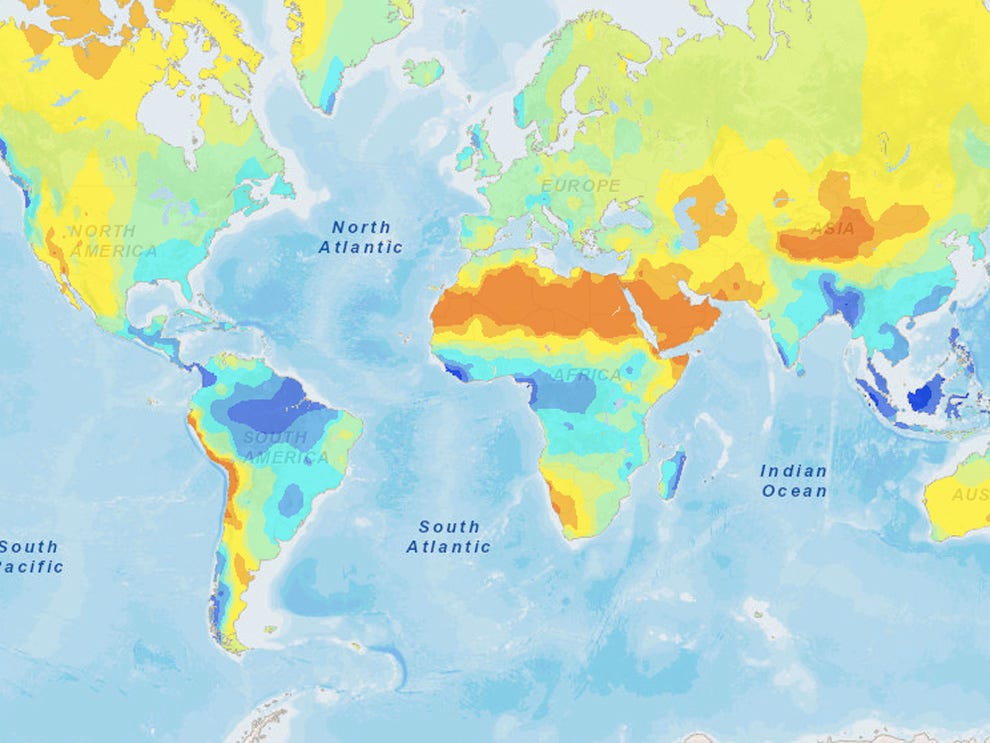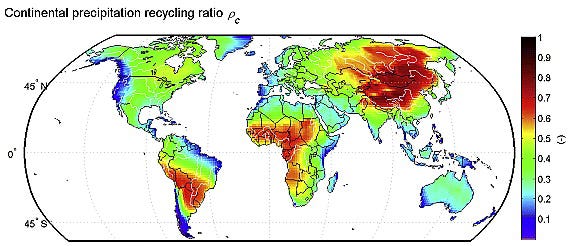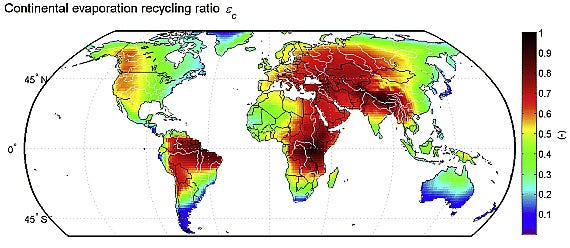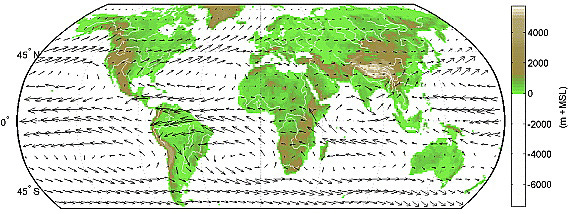Map of the small water cycle
Where the water that evapotranspires comes back down as rain
Here is a map of rainfall around the world. Dark blue represents a lot of rain. Red represents little rain. A question arises - where does the rain come from for each country? Where does the rain in the different parts of the USA come from? Where does the rain from China come from? Where does the rain for the African Sahel come from? How much of the rain in each country comes from the ocean, and how much comes from evapotranspiration over land?
To answer this question of where rain comes from, lets look at the work of the hydrologist Hubert Savenije, and his student Ruud van der Ent.
Hubert Savenije, is a hydrologist from the Netherlands, a country where the field of hydrology is held in high regard, because most of that land is below sea level. After graduate school Savenije went to work in Africa, where he became intrigued with the question of where the moisture goes after it evaporatranspires from the land.
The amount of moisture recycling (small water cycle) depends on the size of the area you look at. If its small, then the amount of moisture recycling is less. The amount of moisture evapotranspired from a backyard that comes back down in the same backyard is pretty small. The amount of moisture evapotranspired from a county that comes back down in that county is somewhat more. Savenije suggested a measure of moisture recycling that took into account the whole continent. He quantified how much does the moisture that evapotranspired from a continent, came back down on the same continent.
He studied where the rain in the Sahel arid region in Africa comes from - “It appears that the recycling of moisture through vegetation is the most important condition for rainfall in the Sahelian belt. This conclusion is important for the hydrologist, but it has even more important implications for the planners and managers of natural resources development in West Africa. Not only does the rainfall in the interior of the Sahel depend significantly on land-use practices in the Sahelian belt itself, it also depends on land-use practices in the Savanna and forest belt. In the Sahel, this means that there are interesting international aspects to this issue (rainfall in Mali and Burkina Faso, for instance, is influenced by land-use in Guinea, Ivory Coast and Ghana), which could be important inputs to discussions on the sharing of international water resources.” [Savenije 1995 “New definitions of moisture recycling”]
He wrote “Recent research demonstrates that impacts resulting from land-use change are more important than the greenhouse effect to explain regional climate change, occurrence of droughts and desertification. The most important mechanism, in this respect, is the feedback of moisture to the atmosphere through evaporation from vegetation which is required to sustain continental rainfall. Land use change, in general, reduces moisture feedback and enhances runoff, resulting in reduction of rainfall, regional climate change, occurrence of droughts, land degradation, and desertification. Particularly in semi-arid continental regions this problem is predominant. In the Sahel the importance of moisture feedback has been clearly demonstrated, but these feedback mechanisms are evident on other continents as well (Eastern Europe, Continental Asia, Southern Africa, South America, USA).”
“In this light, it is remarkable that in the international research environment so little attention is paid to the analysis and quantification of moisture feedback processes, whereas enormous research efforts are dedicated to global warming and GCM predictions, which will not yield any tangible actions to be taken locally. The problem of desertification, however, having its cause in local anthropogenic influences on the land-atmosphere interaction, can be addressed by local and regional management actions. Therefore it is of paramount importance that the physical processes leading to regional climatic change and desertification can be established scientifically and quantified.”
“In addition to the research in the physics of moisture recycling, there is an important need for research into the policy implications of the link between land and water use, climate and water resources availability. If the impact of land and water use on rainfall and water resources availability can be quantified, than the full environmental costs and benefits of certain land use practices can be determined. Land use practises that minimise runoff, and hence maximise moisture feedback, do not only prevent erosion and nutrient losses, but they also sustain continental rainfall. The policy implications for socio-economic development are both of a national and international nature, which may influence the water resources negotiations between upstream and downstream countries.” [Savenije 1995 “Does moisture feedback affect rainfall significantly”]
‘The policy implications for socio-economic development are both of a national and international nature, which may influence the water resources negotiations between upstream and downstream countries.’
Over the next 15 years, Savenije was frustrated by the lack of response from the greater community to what he was saying, to what he saw as the crucial issue of land use and precipitation recycling/small water cycle, and how it affected our water supply.
He was also annoyed that his way of quantifying moisture recycling was not more widely adopted. Then in 2010, one of his Masters students, Ruud van der Ent, said he wanted to try and quantify the moisture recycling. (Van der Ent would later become a professor of hydrology). Using more sophisticated methods, he calculated the precipitation and evapotranspiration rates from meteorological data (from something called the ERA-Interim Data Set), and working with Savenije, they published a scientific paper with the semi-literary sounding title “Origin and fate of atmospheric moisture over continents”
He found that 40% of precipitation recycles globally, 57% of evapotranspiration recycles globally. (This has important implications for water scarcity issues).
This map of theirs shows precipitation recycling - the amount of rain that falls in an area that comes from evapotranspiration. You can see from the map that the US western coastal states has less than 20% of its rain come from evapotranspiration. Most of it comes from ocean. Further inland, 30% -45% of the rain comes from land evapotranspiration.
This map shows evapotranspiration - how much evapotranspiration from an area that will come back down on the land. 50-60% of the evapotranspiration from US coastal states will come back down on the continent further inland. A significant amount of the rain, 60-80%, that gets evapotranspired in Europe, Middle East, and Northwest Asia, will come back down on the continent, as opposed to getting blown out to the ocean.
Here is the map of where the wind blows on average. Following the vectors we can see that in the US, Midwest and Great Plains rain comes from both the southwest. We can see that moisture blows into China from Europe to create rains there.
Summarizing their findings, Van der Ent and Savenije wrote: “Major source regions for continental precipitation are the west of the North American continent, the entire Amazon region, central and East Africa and a very large area in the center of the Eurasian continent. The areas that are major sinks for continentally evaporated water are the northeast of North America, the region around the line Peru-Uruguay, central and West Africa and large areas in China, Mongolia and Siberia. The areas east of the Andes and the Tibetan Plateau are hot spots where both continental moisture recycling ratios are high. Moisture evaporating from the Eurasian continent is responsible for 80% of China's water resources. In South America, the Río de la Plata basin depends on evaporation from the Amazon forest for 70% of its water resources. The main source of rainfall in the Congo basin is moisture evaporated over East Africa, particularly the Great Lakes region. The Congo basin in its turn is a major source of moisture for rainfall in the Sahel. Furthermore, it is demonstrated that due to the local orography, local moisture recycling is a key process near the Andes and the Tibetan Plateau.”
“We conclude that continental moisture recycling plays an important role in the global climate…. we have stressed the fact that all water that evaporates eventually precipitates: what goes up must come down. Although this is popular knowledge, in hydrology this idea is not mainstream. In most water resources studies evaporation is considered a loss to the system. In addition, precipitation is often merely seen as external forcing. For many basin-scale studies this approach may be sufficient, but we have demonstrated that a direct and indirect feedback mechanism can be very important in water resources accounting. Globally, recycled moisture multiplies our fresh water resources by a factor 1.67, but locally this can amount to a factor three (e.g., the Río de la Plata basin in South America), or even a factor ten in western China. Moreover, as we have shown, almost all evaporation from East and central Africa returns to the continent. Thus, we can, for example, conclude that draining wetlands in the Nile basin may increase the discharge of the Nile but will also lead to a reduction of Africa's total fresh water resources.”
These maps by the Dutch hydrologists of the small water cycle deserve to be much better known.
Here is a talk by Hubert Savenije:
………
This is a reader supported publication
References
Keune, Jessica, and D. G. Miralles. "A precipitation recycling network to assess freshwater vulnerability: Challenging the watershed convention." Water Resources Research 55, no. 11 (2019): 9947-9961
Savenije, Hubert HG. "New definitions for moisture recycling and the relationship with land-use changes in the Sahel." Journal of hydrology 167, no. 1-4 (1995): 57-78
Savenije, Hubert HG. "Does moisture feedback affect rainfall significantly?." Physics and Chemistry of the Earth 20, no. 5-6 (1995): 507-513 https://www.sciencedirect.com/science/article/abs/pii/S0079194696000146 , and for pdf of paper https://sci-hub.yncjkj.com/10.1016/s0079-1946(96)00014-6
Van der Ent, R. J., and H. H. G. Savenije. "Length and time scales of atmospheric moisture recycling." Atmospheric Chemistry and Physics 11, no. 5 (2011): 1853-1863
Van der Ent, Rudi J., Hubert HG Savenije, Bettina Schaefli, and Susan C. Steele‐Dunne. "Origin and fate of atmospheric moisture over continents." Water Resources Research 46, no. 9 (2010).






This is brilliant! Adds a whole new dimension to investigating the cause and effect of breaking severe droughts.
Alpha, excellent work. Those are great graphs. Thank you for your sleuthing. I want you to be part of my Global Earth Repair Conference. May 8-12, 2025.